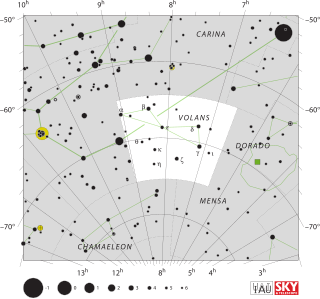
Epsilon Volantis, Latinized from ε Volantis, is a quadruple star system in the southern constellation Volans. This star is at the center of the constellation of Volans and connects the "wings" of the constellation. Based upon parallax measurements, is roughly 640 light years from Earth.
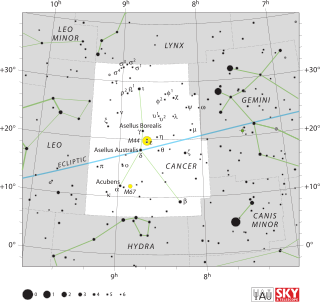
Kappa Cancri, Latinized from κ Cancri, is a blue-white hued binary star system in the zodiac constellation of Cancer. It is faintly visible to the naked eye with an apparent visual magnitude of +5.23. The magnitude difference between the two stars is about 2.6. Based upon an annual parallax shift of 5.3209 mas as seen from the Earth, the system is located roughly 610 light-years from the Sun.
3 Centauri is a triple star system in the southern constellation of Centaurus, located approximately 300 light years from the Sun. It is visible to the naked eye as a faint, blue-white hued star with a combined apparent visual magnitude of 4.32. As of 2017, the two visible components had an angular separation of 7.851″ along a position angle of 106°. The system has the Bayer designation k Centauri; 3 Centauri is the Flamsteed designation. It was a suspected eclipsing binary with a variable star designation V983 Centauri, however the AAVSO website lists it as non-variable, formerly suspected to be variable.

13 Vulpeculae is a blue giant with a stellar classification of class B9.5III in the northern constellation Vulpecula. It is visible to the naked eye as a faint, blue-white hued star with an apparent visual magnitude of 4.57 and it is approximately 339 light years away from the Sun based on parallax. The star is radiating 180 times the luminosity of the Sun from its photosphere at an effective temperature of 8,801 K.

17 Lyrae is a multiple star system in the constellation Lyra, 143 light years away from Earth.
HD 225218 is a quadruple star system in the northern constellation of Andromeda. The primary component, HD 225218 A, is a giant star with a stellar classification of B9III, an apparent magnitude of 6.16, and is a candidate Lambda Boötis star. It has a fainter, magnitude 9.65 companion, HD 225218 B, at an angular separation of 5.2″ along a position angle of 171°. The primary itself has been identified as a binary star system through interferometry, with the two components separated by 0.165″. The pair, HD 225218 Aa and Ab, orbit each other with a period of about 70 years and an eccentricity of 0.515. Component B is likewise a spectroscopic binary.
HD 6114 is a visual binary star system in the northern constellation of Andromeda. With a combined apparent magnitude of 6.46, the star can only be seen with the naked eye by keen-eyed observers even on the best of nights. Based upon an annual parallax shift of 10.4 mas as seen from Earth's orbit, the system is located approximately 108 parsecs (350 ly) distant.
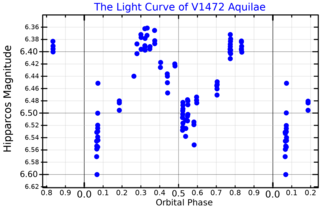
V1472 Aquilae is a triple star system in the equatorial constellation of Aquila. It is a variable star that ranges in brightness from 6.36 down to 6.60. The system is located at a distance of approximately 780 light years from the Sun based on parallax. It is a high-velocity star system with a radial velocity of −112 km/s.

S Monocerotis, also known as 15 Monocerotis, is a massive multiple and variable star system located in the constellation Monoceros. It is the brightest star in the Christmas Tree open cluster in the area catalogued as NGC 2264.

Iota Delphini is a star in the constellation Delphinus. It has an apparent magnitude of about 5.4, meaning that it is just barely visible to the naked eye. Based upon parallax measurements made by the Gaia spacecraft, this star is located at a distance of 196 light years.
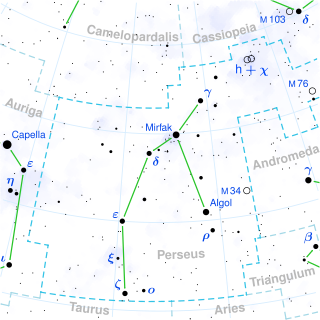
1 Persei is an eclipsing binary star in the constellation Perseus. Its uneclipsed apparent magnitude is 5.49. The binary star consists of two B2 type main-sequence stars in a 25.9 day eccentric orbit. The stars are surrounded by a faint cloud of gas visible in mid-infrared, although whether they are the origin of the gas or simply passing through it is unclear.
ADS 9731 is a star system that consists of six stars, located in the constellation of Corona Borealis. Four of the stars are visually separate in the sky, forming a visual star system, which was resolved using adaptive optics in 1995. Two of these stars were themselves found to be spectroscopic binaries in 1998, resulting in a total of six known stars in the system. It is one of very few multiple star systems known to have at least six members.
c Ursae Majoris is the Bayer designation for a double-lined spectroscopic binary star system in the northern constellation of Ursa Major. It has an apparent visual magnitude of 5.18, which indicates that is visible to the naked eye. Parallax measurements yield an estimated distance of 66 light years from the Sun. The star is moving closer to the Earth with a heliocentric radial velocity of −14 km/s.
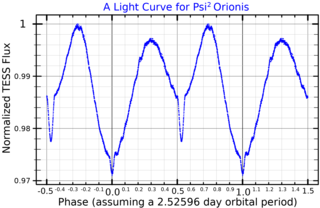
Psi2 Orionis a binary star system in the equatorial constellation of Orion. It has an apparent visual magnitude of 4.6, indicating that it is visible to the naked eye. Based upon an annual parallax shift of 2.87 mass, it is roughly 1,100 light years distant from the Sun.
HD 1, also known as HIP 422, is the first star catalogued in the Henry Draper Catalogue. It is located in the northern circumpolar constellation Cepheus and has an apparent magnitude of 7.42, making it readily visible in binoculars, but not to the naked eye. The object is located relatively far away at a distance of 1,220 light years but is approaching the Solar System with a spectroscopic radial velocity of −27.3 km/s.
HR 3750 is a binary star system in the equatorial constellation of Hydra at a distance of 101 light years. This object is visible to the naked eye as a dim, white star with an apparent visual magnitude of 5.4. It is receding from the Earth with a heliocentric radial velocity of 57.9±0.2 km/s. This binary is unusual because its eruptions do not seem to conform to the Waldmeier effect—i.e. the strongest eruptions of HR 3750 are not the ones characterized by the fast eruption onset. Kinematically, the binary belongs to the thick disk of the Milky Way galaxy - a population of ancient, metal-poor stars.
HD 72945 and HD 72946 form a co-moving star system in the northern constellation of Cancer. HD 72945 is a binary star that is dimly visible to the naked eye as a point of light with an apparent visual magnitude of 5.91. At an angular separation of 10.10″ is the fainter companion star HD 72946 at magnitude 7.25. It is being orbited by a brown dwarf. The system as a whole is located at a distance of approximately 84 light years from the Sun based on parallax measurements.
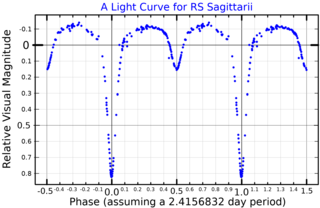
RS Sagittarii is an eclipsing binary star system in the southern constellation of Sagittarius, abbreviated RS Sgr. It is a double-lined spectroscopic binary with an orbital period of 2.416 days, indicating that the components are too close to each other to be individually resolved. The system has a combined apparent visual magnitude of 6.01, which is bright enough to be faintly visible to the naked eye. During the primary eclipse the brightness drops to magnitude 6.97, while the secondary eclipse is of magnitude 6.28. The distance to this system is approximately 1,420 light years based on parallax measurements.

HD 197911 is a bluish-white hued star in the deep northern constellation of Cepheus, close to the border with Draco and Cygnus. With an apparent magnitude of 7.669, it is too faint to be seen by the naked eye under most conditions, but readily visible using binoculars. The star is located some 3,020 light-years distant according to Gaia EDR3 parallax measurements, but is moving closer to the Solar System at a heliocentric radial velocity of −3.8±3.5 km/s.
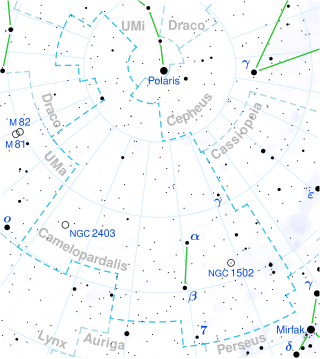
HD 24733 is a spectroscopic binary system that is also a Beta Lyrae variable located about 606 light-years away in the deep northern constellation of Camelopardalis, close to the border with Perseus. It has the variable-star designation DD Camelopardalis. With a mean apparent magnitude of 7.038, it is too faint to be seen by the naked eye from Earth, but readily visible through binoculars.












